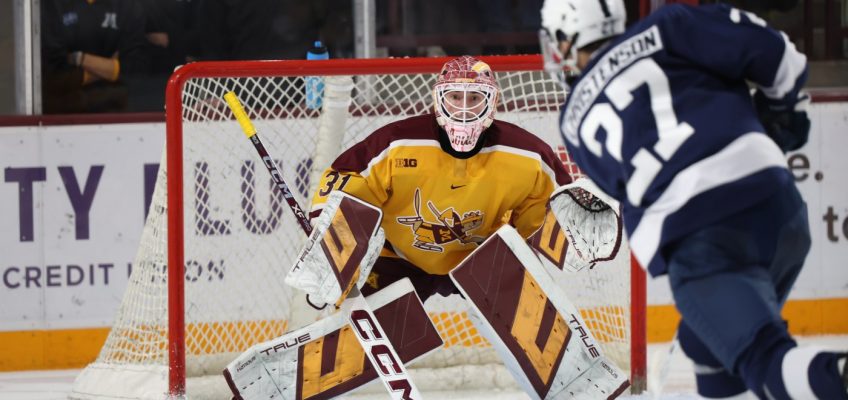Less than two years ago, Liam Souliere was in the crease for Penn State as the Nittany Lions came within an overtime goal of the program’s first Frozen Four trip. Less than a year ago, he earned his finance degree after playing four years at Pegula Arena.
On Friday, Souliere is likely to hear boos when he skates out onto the Lions’ home ice wearing the maroon and gold of the Minnesota Gophers. Souliere faced his former team earlier this season, shutting out the Lions in Minneapolis.
“It adds to it, but I don’t think we view it any differently. It’s just another goalie at that point,” Penn State forward Matt DiMarsico said this week. “I think we know some of the tendencies, and hopefully that will help us out this time. Definitely motivated to not let that happen again.”
There seems to be motivation everywhere this weekend as the Gophers head to State College, where they will close out the Big Ten’s regular season with games Friday (7:30 p.m. CT) and Saturday (7 p.m.).
Last weekend, while Minnesota was sweeping Ohio State at home, the Nittany Lions went to first-place Michigan State and took five of six points from the Spartans. Those results vaulted the Gophers to the top of the conference standings, meaning that if Minnesota grabs five or six points this weekend, Minnesota will win the conference title for the third time in four years.
Gophers coach Bob Motzko said his team isn’t thinking much about that bigger picture, or paying any attention to the out-of-town scoreboard and instead are focused solely on what comes first.
“Win the series against the team you play. We can’t worry about what Michigan State does,” Motzko said this week. “All we had to do last week was worry about who we were playing. And right now it’s Friday night, Penn State, we’re up two on them. We have to win the series.”
Motzko added that his advice to Souliere, who has emerged as Minnesota’s every-night goalie, is to call on his 100-plus games of college hockey experience, and to remember that the net is 4 feet by 6 feet and the puck is the same size no matter who shoots it.
“Just keep your emotions in check. That’s it,” Motzko said. “We just had a speaker in today who said, ‘The moment doesn’t care about you. You care about the moment and just stay in it.’ ”
Minnesota swept a home series with the Nittany Lions in November, which seems like a long, long time ago now. Since January, when they got healthier, Penn State has won 12 of its last 13, backstopped by junior goalie Arsenii Sergeev — honored by the conference as their first star of the week on Tuesday — and led offensively by sophomore Aidan Fink, who is making a case to be a Hobey Baker Award finalist.
Penn State is a notably motivated team this weekend, as well, sitting one point behind Michigan for the final home ice slot in Round 1 of the conference playoffs.
Motzko’s teams have won either Big Ten regular season or tournament titles in three of the past four years, and the Gophers acknowledge that the opportunity to hang another championship banner is in their thoughts.
“We care. Two big wins and that comes with a title,” said Gophers forward Brody Lamb, who scored three times against Ohio State last weekend and was honored with the Big Ten’s second star of the week. “We’ve just got to focus on our game and not think about the stage it is. But we care.”




